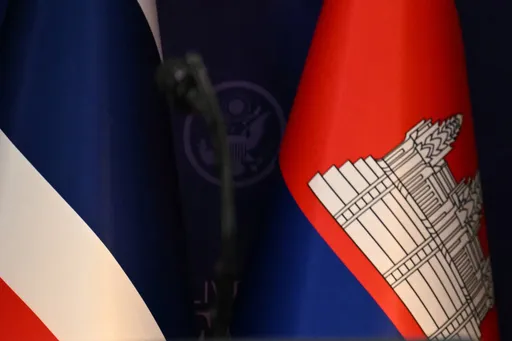Earlier in the week, a massive leak occurred regarding Russian President Vladimir Putin's alleged Black Sea coastal palace, also known as the Residence at Cape Idokopas.
The extremely high-security 168-acre palace reportedly belongs to Putin through an indirect tangled web of associates and shell companies.
Amid raging protests in Russia and rising anti-government sentiment in Russia, the whistleblowing report is damning and has further galvanised an unprecedented public outcry against a traditionally secure regime.
Released by the Anti-Corruption Foundation, also known by its Russian acronym FBK, the Russian report presents a sprawling trove of financial records, documents and never-seen-before exterior images of the palace. The report also provides renderings of the interior based on floor plans procured from a whistleblower. The floor plans reveal staggering opulence, including a casino, theatre, pool, and a hookah lounge with a pole-dancing stage.
FBK estimates that the entire estate is worth approximately $1.4 billion, asserting that nothing like it exists outside of North Korea possibly.
FBK is a Russian non-profit which commits itself to exposing corruption among government officials. The organization is highly critical of Putin. Its founder, Alexei Navalny, was the target of an alleged Russian government assassination attempt last year using a secretive family of Soviet-era chemical weapons, known as Novichoks.
Navalny was medically evacuated to Germany where he recuperated. A day before the palace leak was revealed, Navalny returned to Russia where he was arrested immediately on questionable grounds relating to a 2014 suspended prison sentence and charges of libel against a World War II veteran.
Putin's spokesperson Dmitry Peskov dismissed the report as "pure nonsense." This is in sharp contrast to media reports and whistleblower allegations over at least a decade that have provided evidence Russia's President has been tied to the Black Sea Palace since at least 2000.
In spite of the denial by Putin government, journalists trying to get close to the site by land or sea have been warned off by national security organizations the FSO and FSB, respectively. Both were former KBG branch organisations.
More critically, Navalny's team found an official flight chart demarcating the air above the palace as a no-fly zone.
In spite of this, FBK says it was able to fly a small drone with a video camera over the estate, which it calls 'Putin's Kingdom'.
The palace, fit for a tsar, is the prominent structure. It occupies an area of around 17 square kilometres according to FBK. Navalny's team reports that costs linked to this building have grown substantially over the years. High humidity in the region and faulty ventilation systems gave rise serious mold problems in need of attention. The palace has been under some form of construction for years.
FBK also identified what it said was a greenhouse, as well as an outdoor amphitheater. A very long bridge connects a tea house to the central area of the sprawling estate.
A number of the buildings appear to have been built and rebuilt multiple times, indicating an owner with exacting tastes and deep pockets.
The sprawling estate also has its own offices and dormitories to house staff and security.
FBK also identified an ice rink, built over two helipads, which is not surprising given Putin's well-known fondness for hockey.
During the ice rink's construction which started in 2018, there was speculation that this could be a hardened underground bunker for Putin in the event of a major crisis.
The interior renderings of one of the bedrooms, an attached bathroom, as well as living and reading rooms, reflect an aesthetic matching the regal exterior of the building.
The palace also enjoys several amenities, such as a theatre, pool and casino. FBK reports that adjacent rooms and halls show slot machines and video game cabinets.
Many of the renderings are based in part on what the floorplans specifically names the rooms. Some were relatively less clear.
One room was marked "Hookah," suggesting it included a room where people could smoke from a water pipe.
But the room had no windows, a stage, a dressing room, spotlights and something "very similar to a pole is noted on the plan", says the FBK investigation.
"We thought for a long time what it could be. Perhaps a giant shawarma is prepared here. Or firefighters are training," the FBK quips.
"And here's what happened," it continues.
The report attaches a rendering that makes the room's purpose obvious.
The palace enjoys sprawling Versailles-like grounds, exotic trees and huge sculptures.
The entire facility is surrounded by high-security walls, fencing, and barriers with fortified checkpoints at its entrances. Roads provide access throughout the property.
Some features remain unexplained, including a massive ramp-like setup that seems to be a form of vehicle access into an underground facility. It connects to a growing pier area on the southern border of the estate.
Navalny's organization claims that the Black Sea palace is only one of the multiple properties linked to Putin, including four other sites near Gelendzhik; specifically another chateau, wineries, and an oyster farm.
Putin's future ahead of new potential protests is not yet clear.
The creator of the video presentation that outlined the palace and its features received 10 days of prison for unclear reasons. The video has since received 91 million views.
In December 2020, Putin signed a bill into law granting lifetime legal immunity to former Russian presidents, possibly indicating that he does not expect to remain in power forever. The only other living former Russian President, Dmitry Medvedev does not seem to be at any risk of imminent prosecution.
























